这些附件是根据【原创】流密码内嵌魔方阵于随机存档之研究 所设计出来的东西。
然后接【原创】流密码内嵌魔方阵于随机存档之研究-- Magic Square 篇 继续讨论。
我在前几帖有介绍到 magic square 的应用,今天我更深入介绍 magic square 一些特性。
Magic square 本身是一个 matrix,如果把它应用在 encryption/decryption,算是 block cipher 的一种,我想它被归类在 block cipher 应该不会有人有意见。
截至目前为止,我们所谈论的 magic square 都是 normal type,什么是 normal type?简单的来讲,就是有多少格子,就有多少数字,而且每一个 column ,每一个 row ,及每一个 cross 的总和都相等。
它的万用公式为

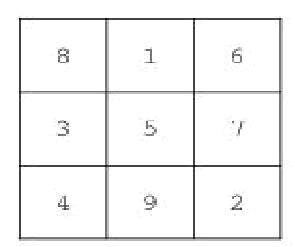
譬如以 3 by 3 为例子,
![]() ,所以 3 by 3 的 magic square 的每一 line 的总和是 15。
,所以 3 by 3 的 magic square 的每一 line 的总和是 15。
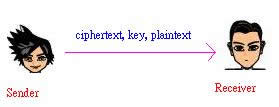
当 sender encrypt 一个东西之后,他最少要传 ciphertext 及 key 这两样东西给 receiver,receiver 根据 key (or password) 来把 ciphertext decrypt 成 plaintext。这是最基本的情况。
如果 encrypt key 及 decrypt key 是一样的,那通常是 symmetric cryptosystem,如果不一样,通常是 asymmetric cryptosystem。
如果要让 receiver 对 sender 做 authenticated 的动作时,sender 至少还要 plaintext, key 及 ciphertext 三种给对方,receiver 可以把 ciphertext decrypt 后,跟原来的 plaintext 比对看看是否一致。
symmetric cryptosystem与asymmetric cryptosystem 各有它的特性,但却无法解决目前的一个问题,什么问题?
Send 最少要传 plaintext 及 key 给 receiver。
有没有什么方式是可以只传 ciphertext 而不用传 key 就可以达到前面所讲的那样?
目前所知的 cryptosystem 技术是办不到的。连 quantum cryptosystem 也不例外。
现在再回过头来讲 magic square。
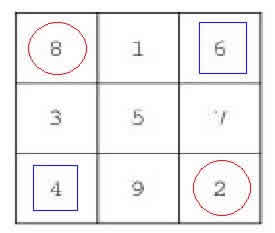
以 3 by 3 magic square 来看,两个对角的和分别是 (8+2)=10,(6+4)=10。
因3 *3 =9,但 10 比9 大1。
再来看 4 by 4 magic square。

两个对角的和分别是 (16+1)=17,(13+4)=17。因 4 * 4 =16,但 17 比 16 大1。
再来看 5 by 5 magic square。

两个对角的和分别是 (17+9)=26,(15+11)=26。因 5 * 5 =26,但 26 比 25 大1。
接着看 6 by 6 magic square。
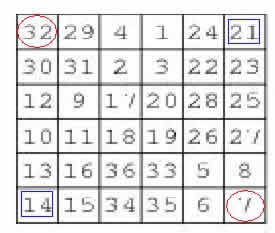
两个对角的和分别是 (32+7)=39,(21+14)=35。这两个对角合不一样,比较特别一点。
先计算 (39+35)=74, 74/2=37,因 6 * 6 =36,但 37 比 36 大1。
接着看 7 by 7 magic square。

两个对角的和分别是 (30+20)=50,(28+22)=50。因 7 * 7 =49,但 50 比 49 大1。
接着看 8 by 8 magic square。
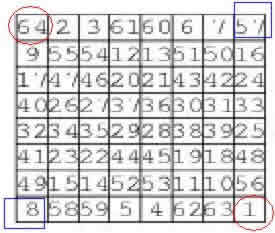
两个对角的和分别是 (64+1)=65,(57+8)=65。因 8 * 8 =64,但 65 比 64 大1。
接着看 9 by 9 magic square。
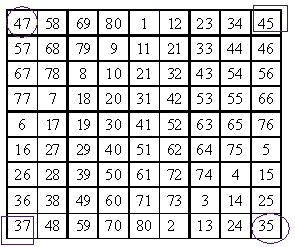
两个对角的和分别是 (47+35)=82,(45+27)=82。因 9 * 9 =81,但 82 比 81 大1。
以上大家可以看出一种很奇妙的特性,就是两个各自对角的总和比格子数 (blocks number) 大1。
除了 6 by 6 比较特别。
如果4个角落总和除以2来计算,还是符合大于1的特性。
现在我也可以造出一个符合大于1特性的 6 by 6 magic square。
看新的 6 by 6 magic square。
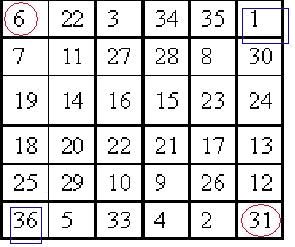
两个对角的和分别是 (6+31)=37,(1+36)=37。因 6 * 6 =36,但 37 比 36 大1。
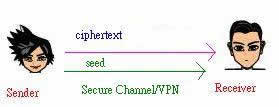
现在再回到 communication environment ,如果 sender 在一般的 network 上传送 ciphertext 给 receiver,另外在 secure channel 或是 VPN 上传送 seeds 给 receiver,这个 seeds 就是 magic square 的四个 corner 及 size of base ,当 receiver 收到 sender 所传送的 ciphertext 及 seed 时,receiver 可以利用自行产生一个 magic square,此时,产生的这个 magic square 就是一个 key,利用这个 key 来把 ciphertext 做 decryption,就会得到 plaintext。
For example:
Sender 传送 seeds 为 (9,47,45,37,35) 及 cipertext 给 receiver 时,receiver 收到后,receiver 知道要产生 9 by 9 magic square,且四个corner 一定是 (47,45,37,35),若不是,receiver 就无法正确的 decrypt ciphertext 为 plaintext。
在【原创】流密码内嵌魔方阵于随机存档之研究-- Magic Square 篇,我所展示的只有用 9 by 9 magic square 来做 encrypt 及decrypt,我是直接告诉您们我用的 是 9 by 9 的 magic square,这次我所介绍的技术与概念是 receiver 自行可以产生 key 来做 decryption,这是目前已知所有的 cryptosystem 所办不到的事。
一个 3 by 3 normal magic square 只有1种,而 4 by 4 normal magic square 有 880 种,可是 5 by 5 normal magic square 却高达 275305224 种。6 by 6 normal magic square 已经是一个 very huge number,而 10 by 10 以上则是 googol number。
这样排列与组合的证明已经有专家及学者证明出来,可以在 How many magic squares are there? 里得到答案。
#include <stdio.h>
#include <stdlib.h>
main()
{ int i,j,x,y,n=2;/* 宣告循环变量i,j,及数组变量x,y,及阶层变量n */
int **magic;/* 宣告数组的大小 */
/* clrscr();/* 消除荧光幕 */ */
while(n>19 || n%2==0){ /* 判断条件是否成立 */
printf("\n 请输入奇数魔术方阵的大小(1-19):");
scanf("%d",&n);
}
magic=(int *)malloc(n* sizeof(int));
*magic=(int *)malloc(n*sizeof(int));
printf("======>%d\n",magic);
x=0;y=(n-1)/2; /* 设定魔术方阵中的第一个位置 */
for(i=0;i<n;i++) /* 将所有的数组设定其值为0 */
for(j=0;j<n;j++)
*(*(magic+i)+j)=0;
*(*(magic+x)+y)=1; /* 设定魔术方阵的第一个值 */
for(i=2;i<=n*n;i++)
{ x=(x+(n-1)) % n; /* 计算方阵往右上的规则 */
y=(y+1) % n; /* 及其x ,y值的变化现象 */
if( (*(*magic+x)+y) != 0){ /* 判断是否会重复 , 如果重复 */
x=((x+2)) % n; /* 计算方阵往下移动到的规则 */
y=(y+(n-1)) % n; /* 及其x ,y值的变化现象 */
}
*(*(magic+x)+y)=i; /* 没有错误,将数字填入魔术方阵中 */
}
printf("--------------%2d阶的魔术方阵------------------\n",n);
for(i=0;i<n;i++){
for(j=0;j<n;j++)
printf("%5d",*((*magic+i)+j));
printf("\n");
}
printf("--------------敬请批评指教--------------------\n");
}